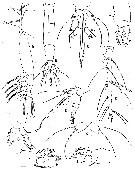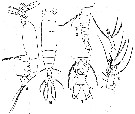|
|
 |
Fiche d'espèce de Copépode |
|
|
Monstrilloida ( Ordre ) |
|
|
|
Monstrillidae ( Famille ) |
|
|
|
Monstrilla ( Genre ) |
|
|
| |
Monstrilla wandelii Stephensen, 1913 (F,M) | |
| | | | | | | Syn.: | no Monstrilla wandelii wandelii : Suarez-Morales, 1996 (p.35, Rem. M) | | | | Ref.: | | | Park, 1967 (p.144, Descr.M, figs.F,M); Isaac, 1975 (p.3, 6, 8, figs.F,M, as M. wandeli ); Threlkeld, 1977 (p.226); Grygier, 1995 a (p.22, 78); Shih & al., 1971 (p.157); Gardner & Szabo, 1982 (p.90, figs.F,M); Suarez-Morales, 2011 (p.10); Grygier & Suarez-Morales, 2018 (p.505: Rem.: ). |  issued from : T.S. Park in Trans. Amer. Microsc. Soc., 1967, 86 (2). [p.145, Fig. 1]. Female (from Strait of Georgia): A-B, habitus (lateral and dorsal, respectively); C-D, posterior portion of body (ventral and lateral, respectively); E, A1; F, P1; G, P2; H, P3; I, P4; J, P5. Nota: Cephalosome including the 1st metasomal segment about 1.5 times as long as the rest of the body; its surface is finely rigose. Prominent oral papilla located about halfway along the ventral side of the cephalosome. Posterior portion of the body, which consists of the 4 rear segments of the metasome plus the 3-segmented urosome, is progressively narrower posteriorly. Genital segment about as long as the combined length of the two following urosomal segments, and bears ventrally 2 ovigerous spiniform processes, which extend close to the end of the caudal setae; ventrally, it also bears a knob-like process in front of the ovigerous processes. Caudal rami bear 5 setae (2 lateral and 3 terminal, the 2nd lateral seta is short and about equal in length to the caudal ramus, the remaining 4 setae are equally long). A1 about 5/7 the length of the cephalosome including the 1st metasomal segment; it has only one articulation, by which a small proximal segment is separated from the rest of the appendage; none of the setae are dichotomously branched. P5 short and 1-segmented, each distally divided into 2 lobes, the outer lobe bears 2 subequal setae, but the inner lobe lacks setae.
|
 issued from : T.S. Park in Trans. Amer. Microsc. Soc., 1967, 86 (2). [p.146, Fig.2]. Male: A-B, habitus (lateral and dorsal, respectively); C, posterior portion of body (lateral and ventral, respectively); E, A1. Nota; Cephalosome including the 1st metasomal segment, slightly longer than the rest of the body, its surface finely rugose as in female. Genital segment bears ventrally a prominent genital protuberance with a pair of genital lappets, which have the structure of a chela, 3 urosomal segments follow the genital segment. Caudal rami similar to those of the female, but each has only 4 setae (2lateral and 2 terminal, the 2nd lateral seta short and equal in length to the caudal ramus as in the female). Both A1 geniculate, 5-segmented, with the knee-jpint between segment 4 and 5. The first 4 pairs of swimming legs are identical with those of the female. P5 consist of a pair of identical small lobes, each bearing distally 1 long seta.
| | | | | Ref. compl.: | | | Galbraith, 2009 (pers. comm.) | | | | NZ: | 3 | | |
|
Carte de distribution de Monstrilla wandelii par zones géographiques
|
| | | | Loc: | | | W Greenland, NE Pacif. ( Strait of Georgia, Vancouver Island region, Puget Sound) | | | | N: | 4 | | | | Lg.: | | | (746) F: 2,46-1,98; M: 1,63; {F: 1,98-2,46; M: 1,63} | | | | Rem.: | According to Park (1967, p.149) in spite of the considerable difference in geographical distribution, the specimens in the Strait of Georgia (British Columbia) are identified mainly on the basis of similarities as the rugose surface of the cephalosome, the setation of the caudal rami and P5. However, Stephensen's (1913) figure of the P4 shows no setae on the basis, 2 setae on the 2nd, and 4 setae on the 3rd exopodal segment (these differences could have resulted from the author's mistake, and thus might not be signific. The male is closely related to Monstrilla conjunctiva, established on a single male by Giesbrecht (1902), but differs from the latter in the following respects: the genital lappets are forked insteead of ending in a simple point, and the external spines of the exopods of the swimming legs are relatively longer.
After Grygier & Morales (2018, p.505) exist option to reduse the senior taxon to the subspecies M. wandelii mariaeugeniae (with M. w. tropica as its junior subjective synonym) along with the nominotypical sbspecies M. w. wandelii Stephensen, 1913, known from Greenland and the Canadian and Alaskan Pacific. | | | Dernière mise à jour : 17/02/2020 | |
|
|
 Toute utilisation de ce site pour une publication sera mentionnée avec la référence suivante : Toute utilisation de ce site pour une publication sera mentionnée avec la référence suivante :
Razouls C., Desreumaux N., Kouwenberg J. et de Bovée F., 2005-2026. - Biodiversité des Copépodes planctoniques marins (morphologie, répartition géographique et données biologiques). Sorbonne Université, CNRS. Disponible sur http://copepodes.obs-banyuls.fr [Accédé le 07 janvier 2026] © copyright 2005-2026 Sorbonne Université, CNRS
|
|
 |
 |





